Arthur Emms was born in Saxlingham in September1890. He was the fourth child of James and Mary Ann Emms (nee Poyntz) He had an elder brother, James, born in 1886, and two older sisters, Bessie, born in 1888, and Alice, born in 1889. He also had two younger brothers, Ernest, born in 1893 and John in 1897.
School records show that Arthur started at the village school in 1895 and left in 1903. In 1911 he was living with his parents at Salletts Farm, Saxlingham Thorpe (as a result of boundary changes this is now part of Saxlingham Nethergate) along with his brother, Ernest, and sister, Bessie. He was working on the farm. His brother James, junior, was in charge of Old Hall Farm, Woodton and his sister, Alice, was James’ house keeper. Also living with them was John, who was still at school.
On 23rd January 1912 he married Martha Eva Dade in Saxlingham Nethergate Church. She came from Saxlingham Nethergate too and in 1911 was working as a dairy worker.
Their first son Stanley Arthur was born on 26 April 1912 and their second son, Bertie Ernest on 18th April 1913. Sadly Martha, also known as Molly, died on 26th October 1914 as a result of the birth of their third son, Tommie Albert. Tommie died on 1st November 1914, the day after her funeral. Her funeral was reported in detail in the Eastern Daily Press on Monday, November 2nd 1914.
A recruiting meeting was held in Saxlingham Nethergate on 21st November 1914 and five men from the village enrolled. Arthur joined the Norfolk Regiment on 21st November 1914; so it is assumed that he was one of these five men. He was enrolled by Mr E.H Taylor, the Saxlingham recruiting agent. He joined only 3 weeks after the funeral of his wife and the death of his son.
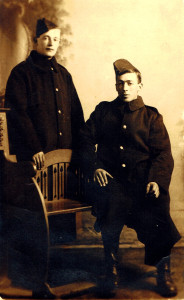
Arthur Emms (seated) with Alfred Funnell who enlisted on the same day and who was also killed in the war
When he had his medical for joining the army, he was described as being 24 years and 2 months old, 5 feet 6 inches tall and weighing 9 and a half stones Until the end of 1915 he was based in England arriving in France at Etaples on 30th December 1915. His regimental number was 16741.
During May 1915 a ploughing match was held at the Cricketers Arms on Saxlingham Green, in which 26 competitors took part. One of the men who won prizes for excellent furrows was an A. Emms. Arthur was still stationed in England at this time and so it is assumed that it was him.
On 15th November 1915 he transferred from the Norfolk Regiment to the 10th Battalion Border Regiment, which was based in Cumbria. His regimental number was 21384. Then as part of 8th Battalion he was stationed in France from the beginning of 1916. He was wounded on 7th July 1916 with gunshot wounds to his hand and neck. He was transferred to Etaples for treatment where he stayed until 28th July when he rejoined his battalion.
On 23rd October 1916 he received a gunshot wound to his left thigh. He was initially taken to the general hospital in Wimereux, and then transferred to Dewalden Court Hospital, Eastbourne on 26th October 1916. From the 13th November until 2nd December he was treated in Tappington Grange, Wadhurst, and was transferred to V.A.D. hospital in Battle on 3rd December1916. He was discharged from there on 3rd January 1917. On being discharged from hospital he went to Salletts Farm on leave until 13th January 1917.
Arthur was posted back to France, and arrived in Boulogne on 9th February 1917. He was sent back into the field as part of 11th Battalion, Border Regiment on 6th March 1917.
During the next few months the 11th Battalion was involved in fighting on the front line and acting as reserves. When not fighting the men were involved in working parties, burying the dead, clearing and making new trenches and repairing bridges and roads. Much of April, May and June were spent with these activities plus training, doing drill, having baths, receiving new clothes, doing church parades and recreation.
At the beginning of July the 11th Battalion was sent to the front lines at Nieuport in Belgium.
On 10th July the Germans subjected them to heavy bombardment from 6 a.m. and this continued for hours. The shells from the British side fell short of the enemy positions. In the middle of the day the Germans fired gas shells which caused people to sneeze, affected their eyes and throats and caused some people to be violently sick. By mid afternoon the front line and the second line were badly damaged along with the communication trenches. Shelling and the use of gas continued and by the evening the Germans had taken over these trenches.
During the course of this battle, Arthur was wounded and taken prisoner by the Germans. He was reported as missing on 10th July. Information was received on 14th July that he was a prisoner of war in Linburg. He died as prisoner of war on 18th July 1917 and was buried in the town cemetery in Bruges. At the end of the war his body was moved with 32 others, who had been buried there, to Larchwood Railway Cutting Cemetery.
This is small cemetery about three miles from Ieper at the side of a railway line. It is accessed by a rough track. The cemetery was begun in 1915 but was enlarged after the Armistice to include graves from the surrounding area and German cemeteries.
His children were cared for by his parents, Mary Ann and James Emms. Mary Ann was listed as their guardian and eventually received a pension of 13 shillings a week from April 1918 for their upkeep. She also received Arthur’s medals, The Victory medal, The British Medal and 1915 Star (as he had arrived in France in 1915) on behalf of the children with the understanding that they would be given to them when they were old enough to appreciate their significance.
Arthur’s brother, Ernest was a member of the Norfolk Regiment and returned safely. His cousin John Frederick Emms also died during the war and is remembered on the memorial in the Church but not the village memorial as he no longer lived in the village when he enlisted.
Descendants of Arthur and Martha still live in the village and are farmers.
Acknowledgements
Census records: 1891, 1901, 1911
Saxlingham Nethergate School log book.
British Army WW1 Service Records.
UK soldiers who died in the Great War 1914-18
British Army WW1 Medal Rolls Index Cards 1914-1920.
Eastern Daily Press. 2nd November 1914 and 28th May 1915
Papers from Saxlingham Nethergate Church Chest now deposited at Norfolk Record Office.
11th Battalion, Border Regiment, War Diary, March till July 1917. Transcribed by K. Johnstone.
Thanks to the Emms Family for photographs of Arthur and Martha on their wedding day and Arthur in his dress uniform.

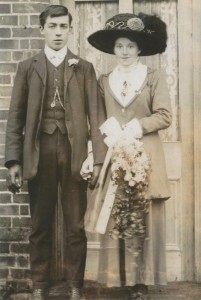
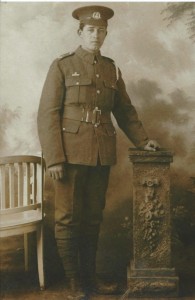
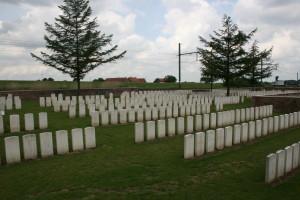
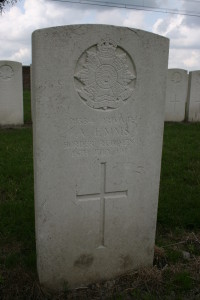
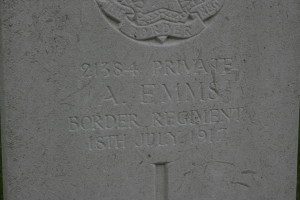
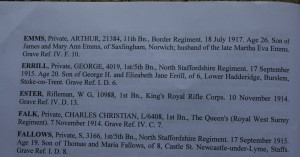
To whom it may concern. Thank you very much for filling in a part of my life that was missing. I have a photograph of my Grandfather but have always wondered what my Grandmother looked like and it brought a tear to my eye to see the photograph of my Grandfather and Grandmother on their wedding day. I knew a little about my Grandparents but my Mother died when I was fifteen, so I never really got a chance to ask her and my Father (Bertie Emms) never spoke about his parents. I gleaned bits and piece from Aunts and Uncles. So again, many thanks for filling in the blanks. Such a sad story but I am so proud to have had them as my Grandparents and I have made sure my children and grandchildren know all about them.
Thank you for your kind comments.
After speaking to my half cousin Susan, I too would like to thank you for filling in the gaps about Arthur Emms who is my great grandfather too.. My grandfather is Ernest Emms, and my father Ernest Albert Emms. My father was crippled by disease in his hip as a teenager so did not have to leave the farm during WW2. I have all my grandfather’s discharge papers from WW1 with many other documents .retrieved from my late father’s things after he passed away in the 80’s. I visited the family graves this week. Saxlingham residents as I knew them when I left in 1968 after marrying in the church, are now almost all in the graveyard. It saddens me every time I see a new grave. I still have so much to read about the Emms family now that in Lockdown I have all the time I need. Thank you very much. Keep well
Thank you for your comments, it was interesting to hear more details about your family. I am pleased that you found more information about your family from the website.